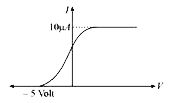In the photoelectric experiment, if we use a monochromatic light, the I – V curve is as shown. If work function of the metal is 2 eV, estimate the power of light used. (Assume efficiency of photo emission =10−3 i.e. number of photoelectrons emitted are 10−3 times of number of photons incident on metal).

2W
5W
7W
10 W
The correct Answer is:C
The energy of incident photosn is given by
hv=eVs+ϕ0=2+5=7eV (VS is stopping potential and ϕ0 is work function)
Saturation current =10−6A=ηPhve=10−5P7×ee (η is photo emission efficiency)
∴P=7W.
Topper's Solved these Questions
Similar Questions
A photon of wavelength 4×10−7m strikes on metal surface , the work function of the metal being 2.13eV Calculate :
(i) the energy of the photon (ev)
(ii) the kinetic energy fo the emission and
the velocity of the photoelectron (1eV=1,6020×10−19J),
View SolutionIn a photoelectric experiment a parallel beam of monochromatic light with power of 200W is incident on a perfectly absorbing cathode of work function 6.25. The frequency of light is just above the threshold frequency so that the photoelectrons are emitted with negligible kinetic energy. Assume that the photoelectron emission efficiency is 100%. A potential difference of 500V is applied between the cathode and the anode. All the emitted electrons are incident normally on the anode and are absorbed. The anode experiences a force n×10−4N due to the impact of the electrons. The value of n is __________. Mass of the electron 9.1×10−31Kg and charge is 1.6×10−19C
View SolutionA photon of wavelength 4×10−7 m strikes on metal surface. The work funcation of the metal being 2.13eV. Calculate (i) the energy of the photon (eV) . (ii) the kinetic energy of the emission, and (ii) the velcoity of the photoelectron (1eV=1.6020×10−19J)
View SolutionA photon of wavelenth 3000 A strikes a metal surface, the work function of the metal being 2.20eV. Calculate (i) the energy of the photon in eV(ii) the kinetic energy of the emitted photo electron and (iii) the velocity of the photo electron.
View SolutionA photon of wavelength 4×10−7m strikes on metal surface, The work function of the metal is 2.13eV. The velocity of the photo electron is
View SolutionA monochromatic light of wavelength λ is incident on an isolated metallic sphere of radius a. The threshold wavelength is λ0 which is larger than λ. Find the number of photoelectrons emitted before the emission of photoelectrons will stop.
View SolutionWork function of a metal is 3.0 eV. It is illuminated by a light of wavelength 3×10−7 m. Calculate the maximum energy of the electron.
View SolutionA light of intensity 16 mW and energy of each photon 10 eV incident on a metal plate of work function 5 eV and area 10−4m2 then find the maximum kinetic energy of emitted electrons and the number of photoelectrons emitted per second if photon efficiency is 10%.
View SolutionTwo metallic plate A and B , each of area 5×10−4m2, are placed parallel to each at a separation of 1cm plate B carries a positive charge of 33.7×10−12C A monocharonatic beam of light , with photoes of energy 5eV each , starts falling on plate A at t=0 so that 1016 photons fall on it per square meter per second. Assume that one photoelectron is emitted for every 106 incident photons fall on it per square meter per second. Also assume that all the emitted photoelectrons are collected by plate B and the work function of plate A remain constant at the value 2eV Determine
(a) the number of photoelectrons emitted up to i=10s,
(b) the magnitude of the electron field between the plate A and B at i=10s,and
(c ) the kinetic energy of the most energotic photoelectrons emitted at i=10s whenit reaches plate B
Negilect the time taken by the photoelectrons to reach plate B Take ε0=8.85×10−12C2N−m2
View SolutionCalculate the velocity of a photo-electron if the work function of the target material is 1.24eV and the wavelength of incident light is 4.36×10−7m. What retarding potential is necessary to stop the emission of the electrons?
View Solution
